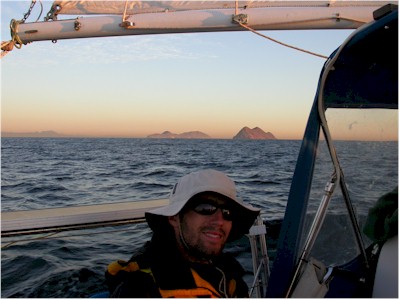
Off Islas Coronados, Mexico
 |
|
Off Islas Coronados, Mexico |
With the tattered shreds of our cruising kitty from our San Diego blowout, we set sail on the afternoon of November 16 with Pelican's bow pointed to Mexico, destination Bahia Tortugas (Turtle Bay). For this 350-mile leg, we decided to buddy-boat with our friends on Rouser. The first 12 hours out of San Diego, we were able to sail at a good pace with the wind on our aft starboard beam. Our first night was a beautiful clear night, almost full moon and the temperature so warm we only needed one layer of fleece at night.
Rouser had informed us that they'd caught a nice tuna the afternoon of our second day out so at dawn the next morning, Michael put out our trolling cord and a white/pink squid lure. Not 30 minutes later I was awakened by the yell "FISH ON!" from the cockpit. Together with our gaff we pulled in a very nice 20 pound Albacore tuna! While Michael was beginning the carving process, I threw out our line again (having had absolutely no success at fishing on the previous 2000 miles, and thinking we might get another fish in the next three days). Two minutes later TWANG our line was taut again and we pulled in another tuna, this one around 15 pounds. We were able to free this guy and throw him back to the sea as we already had more meat than we knew what to do with. After the bloody slaughter on the side deck with the first tuna, we had ourselves at least 10 pounds of great tasty albacore meat. Now all we needed was fresh tortillas for fish tacos!
|
Breakfast! (and lunch, and dinner...) |
For these two days, we sailed and motored off and on in winds that never got over 15 knots. We even put our spinnaker up one day and had a nice downwind ride in about 8 knots of wind. Of course, Rouser, a Tartan 37, flew right by us when they put up their beautiful bright new gennaker from UK sails. We had a great time in the sun and brilliant blue sea seeing who could eek out the most knots of boat speed in the light winds. We were very happy with Pelican and her huge genoa as she was able to keep up with the Tartan all the way to Turtle Bay. The wind would typically die completely at night and we would have to motor for a few hours as it would make us cringe to hear our aging sails slogging around. On our third day out, we discovered a tear in the genoa's luff, several small tears in the main around the battens and a parted mainsail slide (held on with webbing). It is clear to us that we are going to have to baby these old sails along if they are going to last all season.
On our third and final morning out, we were elated at what was our best passage yet -- warm air with nice mellow winds. We were surprised when right before we entered the bay, we realized that after three nights we'd gotten into a good routine and felt like we could have easily kept sailing. It really helped having our friends nearby; we'd have radio contacts at least once per watch. All of us agreed it helped break the monotony and was comforting having another boat nearby. On the afternoon of the 19th we sailed right into Turtle Bay on a brisk close haul, right past a group of whales surfacing near the boat, and dropped our hook in the large bay amongst 20 or so other boats.
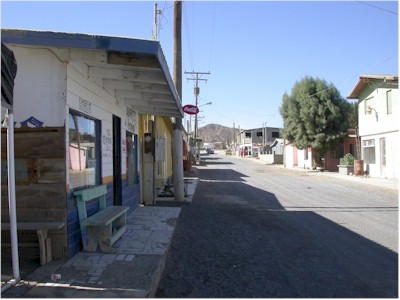 |
|
Main Street, Bahia Tortugas |
Thankfully, Turtle Bay has no Port Captain so we wouldn't have to run through that dance until we got to Cabo. The next day after we arrived and rested up we were free to explore the dusty little town. Bahia Tortugas is a classic remote dusty Baja town; to get there by car it's 135 miles from Baja's Highway 1 via unpaved dirt road. Taking our dinghy through the surf onto the small beach in town we were greeted by smiling local kids who happily helped us carry our dinghy up the sand.
We toured the whole town on foot in about two hours; the whole place had such a marvelous laid-back feel; dusty dogs asleep in the shade, music blaring out of some of the modest dusty homes, laundry drying in the morning sun (probably dusty too). The town had several smaller grocery stores; we were pleasantly surprised to find a large variety of products available and no where near the high prices we'd heard about in such publications as Latitude 38 (assuming you weren't buying American peanut butter and Frosted Flakes).
Back at the beach, we joined the other gringos at the small palapa bar and slurped down 7 peso cervezas ($.70 beers). Every afternoon at 1400 the cruisers would meet here and gab until the sun set. It was such a lovely setting, friendly folks, and such nice cold beer I imagine some cruisers stay here year-round....
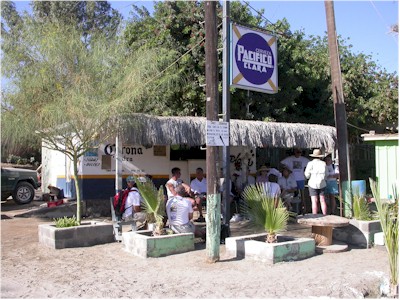 |
|
Paradise? |
Since we only needed about 10 gallons of diesel to top off our supply, along with Rouser we walked with our jerry cans into the Pemex station in town to fill them up. As the four of us began lugging the heavy full cans the 1/2 mile or so back to our dinghies parked at the beach, we passed the local police station. The two officers on duty waved us down and told us in Spanish to get into their truck with all the diesel jugs and they'd drive us down. Once loaded in, they zipped us down to the beach and pulled up right in front of the cerveza palapa and helped us unload our cargo near the dinghys. What great guys!
We spent what we'd planned to be our last day in Turtle Bay exploring the town a bit more, buying a few groceries and sampling some local fish tacos. When we caught wind of some friends having a fish barbeque on the beach the next day we decided it certainly wouldn't hurt to stay another day in this lovely place.
The next afternoon, the crews of Waking Dream, Rouser, Zebedee, Kula, and Pelican met on a beautiful empty sunny hot beach on the bay where we barbequed some fresh caught tuna and fixed up some scrumptious fish tacos with plenty of beer and tequila. It was a great day on the beach, complete with kite flying and frisbee. As it was a Saturday and some locals had told us about a hopping discothèque in town, several of us decided to go in to check it out. Indeed, as midnight rolled around, the little room was blaring with American pop music and at least 100 locals filling the dance floor. We couldn't help but join in the fun. As we didn't get to bed until pretty late, we knew we couldn't possibly leave the next day so another day it would be in Turtle Bay.
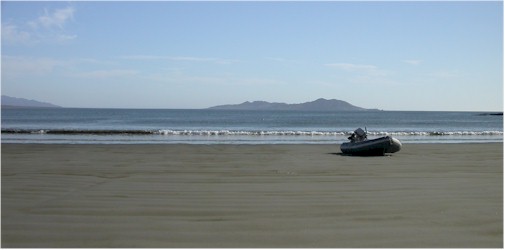 |
|
This is what we came for |
Our final (really this time) day in Turtle Bay was another pleasant warm day of visiting with new friends, picking up some fresh groceries in town and using a payphone to call our families back home.
Just about every morning we listen to the Baja Net (7238 kHz LSB daily 1600Z) and the Chubasco Net (7294 kHz LSB 1445Z) both of which have good weather reports. Our ham setup has really paid off for the weather reports we receive both via the nets and also the weather charts we can receive via Winlink on our Pactor modem. Then of course we all get on the VHF and chat about the weather reports we'd just heard for the next half hour or so. Our two radios on board have been our major source of entertainment; the VHF is basically our telephone -- more like a party line as all the other boats in the anchorage listen in to all the conversations going on.
Several days before Thanksgiving with good weather reported for the next couple of days, we sailed out of Turtle Bay with a number of other boats, our destination this time Bahia Santa Maria outside of Magdalena Bay 250 miles south. For the first 12 hours out we had a great sail, first on the beam then as we turned more south on our starboard quarter. For this trip, Kula and Waking Dream were nearby and it was fun talking to each of them on the VHF along the way, comparing winds and fish caught (us = 0).
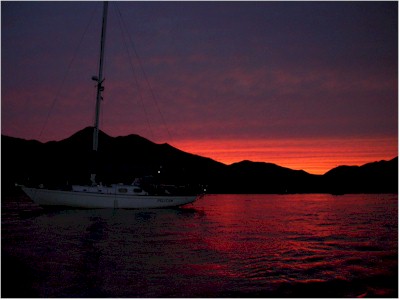 |
|
A lovely Mexican sunset |
Around midnight the first evening, our winds totally petered out and the sea turned to glass. We were disappointed as conditions remained this way for the next 36 hours when we arrived at Bahia Santa Maria. In the morning just before we arrived at Santa Maria, we finally got a bite on our trolling line and were bummed to pull in a small 8 lb. or so skipjack tuna. We released him from the hook and threw him and the line back in. A minute or so later another bite. Same kind of fish and also too small to keep. We threw him back too and before we got the line strung all the way behind the boat we had another bite. Another small skipjack! The line went out again (this time with a different lure) and another bite! All in total we brought in about 9 of these little fish until we finally gave up and took the line in.
Soon after we were anchored in Bahia Santa Maria, a nice large bay surrounded by sand dunes, a mangrove lagoon and tall rocky hills. That evening we had dinner aboard Kula who were very gracious to share some of the dorado they had caught on the trip down. Our friends also reported their water temp sensor was reading 76 degrees! Strange enough, during dinner we began hearing a pitter-patter up on deck. Thinking we may be being attacked by desert bugs we went outside to be surprised by -- rain! Indeed, the "pineapple express" predicted on the weather forecasts had arrived along with some much needed moisture.
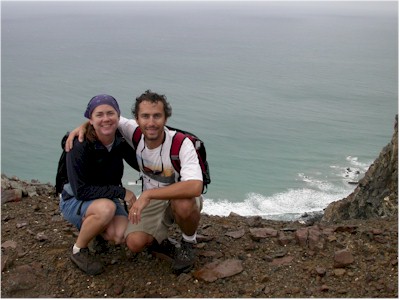 |
|
Santa Maria Hiking View |
The next day just happened to be Thanksgiving, so we along with Kula and Waking Dream set about cooking up a feast. And feast we did on fresh grilled dorado and lobster, mashed potatoes, yams, fresh baked bread and of course, pumpkin pie. Lest you begin to think this was like any old Thanksgiving, our crazy friends on Waking Dream pulled out from a locker some giant fireworks. They launched these huge fireballs from their dinghy near the head of the bay to the cheers of the other anchored boats and also some Mexican fishermen nearby.
That evening we pulled out our cell phone (remember the one we'd got programmed in Tijuana?) and finally gave it a try. Amazingly in this wild rural bay we got through to all of our parents up in the states! It was truly great to talk to our families in person on this holiday.
Tired and stuffed full, we returned to Pelican that evening ready for a good long uninterrupted sleep. That wasn't to be this night as around 11 pm the wind suddenly kicked up from the exposed south side of the bay. Four foot wind waves quickly developed and we spent the next sleepless eight hours on anchor watch (consisting of clinging to the lurching v-berth and cursing wind, waves, boats and all things water related). About an hour into the blow, we had to go up onto the bouncing foredeck and re-stitch the hose chafe guards that had begun to slip down our anchor snubber line. Were we glad the water was 76 degrees as quite a few waves came splashing over the bow while stitching in the pitch dark!
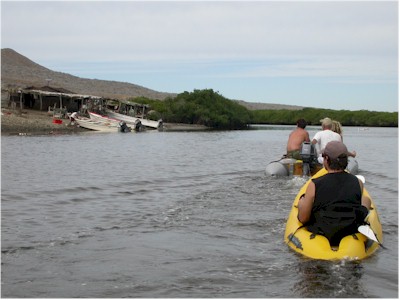 |
|
Mangroves, fish camp, and friends |
Luckily by morning the wind had died down almost completely, but large swells continued to roll into the bay from the south for the next few days. We put out a stern anchor to keep the bow into the swells and was fairly comfortable after that. We were well into the pineapple express now as by noon rain had begun pouring down literally in buckets. Fresh water filled our dinghy and we were able to transfer 10 gallons into our sunshower. It was raining so hard that both of us actually showered in the warm rain in the cockpit! A true desert welcome!
The next few days we spent exploring the bay with friends by snorkeling and hiking through the rocky barren hills. One day we took our dinghies through the surf into a fascinating mangrove lagoon at the head of the bay. The lagoons appeared to snake around for miles, lined on both sides by the bright green mangrove bushes. Scattered throughout the canals were a few Mexican fish camps. Some areas were quite shallow and we'd have to walk the dinghy over them, being careful not to get our toes bitten by the crabs hiding in the sand in the dark water. Back in the bay we walked around the large sandy beach, marveling at all the huge sand dollars scattered about, giving the beach the nickname "frisbee beach", not to mention the thousands of other beautiful seashells.
After a few wonderful days of exploring Bahia Santa Maria between rain showers, and enjoying our first truly spectacular sunsets, we were ready to hit the town at Cabo San Lucas, also our first tropical port.